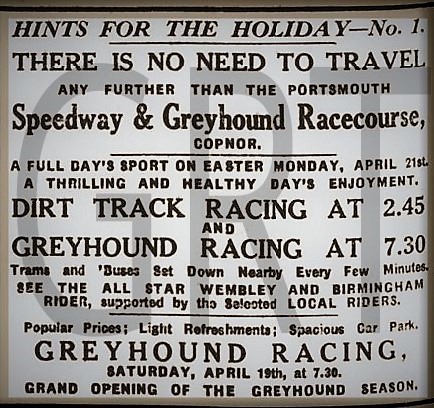Copnor Gardens, Lichfield Street, Copnor, Portsmouth, Hampshire.
POSTCODE———————————-PO3 6DN
LOCATED————————————-The district of Copnor lies on the eastern side of Portsmouth, with the venue sandwiched between todays Walsall Road and Tamworth Road the land is now known as Tamworth Park.
ORIGINAL SITE——————————Marshland prone to flooding in high tides.
DATE CONSTRUCTED——————–1928
DATE VENUE OPENED——————-1928
Meaning other sports may have taken place prior to the arrival of Greyhound Racing.
FIRST MEETING—————————–June 30th 1928.
Greyhound Racing only.
LICENSED OR INDEPENDENT———-Independent
All venues covered would have to be licensed with the government, licensed suggested in this section would refer to tracks operating under NGRC Rules.
INSIDE OR OUTSIDE HARE TYPE——Possibly trackless type.
Please note that the Electric Hare suggested is only a guidance and would have been in operation for a certain amount of time at this venue. Although it is not necessarily guaranteed that it was operational all the time, as other types of lure may have been used and updated as time progressed.
DISTANCES———————————–525 and 610 yards.
Please note that most racing venues distances had become varied throughout the years, the ones given above were at once point set and offers only a guidance to the track size.
CIRCUMFERENCE—————————Dont know.
Please note that alterations at most racing venues throughout its existence would see that the circumference of the track would vary, the one shown above offers only a guidance to the track size.
BIG RACE NAMES—————————None known of.
STADIUM SHARED WITH—————–Speedway
LAST MEETING——————————November 29th 1930.
Greyhound Racing only.
STADIUM CLOSURE DATE—————1930
Meaning other sports may have taken place after Greyhound Racing had ceased.
STADIUM DEMOLITION——————Used by the council as a storage depot and stables for a period before demolition.
BUILT ON SITE——————————Some housing on Tamworth Road and Walsall Road with the rest of the land being landscaped to form a recreational ground known as Tamworth Park.
In some cases, structure’s that originally covered the venue after the stadium had been demolished, may have been themselves demolished too, so the one described is more likely to be the one which now presently covers the site.
EVIDENCE LEFT TODAY——————Nothing known of.
FURTHER COMMENTS——————-Located near the seafront, the land suffering from drainage problems. Meaning both greyhounds and speedway were badly affected by the racing surface becoming waterlogged.


Image provide courtesy of Mr A Nash.




When researching the history of Greyhound Racing in the Portsmouth area, the NGRC track at Tipnor, which closed in March 2010, still remains clear in the memories of those who once attended it. Yet those who still do carry those fond memories, are very unlikely to remember Portsmouth’s first attempt to promote Greyhound Racing. Those attempts happened at the Wessex Stadium, a venue found in the district of Copnor, an area located about one mile east of Portsmouth town centre.
But there was a link between the track at Copnor and the track at Tipnor, as both venues happened to be built by the same company, a company who had initially made a grave mistake by constructing a greyhound track too close to the sea. Construction began of the newly named Wessex Stadium in 1928, on a desolate section of marshland, which in itself had become difficult to drain due the site being situated just above sea level, and less than 200 yards from the sea front. Although aware of the drainage problems the laying and preparation of the greyhound track continued.
Once built the venue was primitive indeed, it had little cover for spectators and it would take until 1930 before any reasonable shelters were built. The first Greyhound Racing meeting was on the 30th of June 1928, with six dog race events being run over 525 and 610 yards.
Although greyhound racing was being staged regularly, the high tides of the sea had been causing disruptions during some meetings, this due to the inevitable flooding taking place. But the introduction of Dirt track speedway in August 1929 did not improve things either, as they too suffered even more than the dogs with a waterlogged track forcing arranged meetings being cancelled. With the continuation of flooding problems it came as no surprise when the council refused to renew the lease, as plans had been put forward to redevelop the site. Their plans would be to build a new sewer which in turn would see the construction of new housing on the site of the old Stadium.
The news had come as a saviour for the greyhound company, which in turn gave them the opportunity to look for a new site in the city to stage their sport, all of which contributed to the birth of the new track at Tipnor opening in May 1931. The news had brought on the inevitable closure at Copnor, with the venue staging its final meeting on the 29th of November 1930, with the speedway closing one month earlier. Once closed the majority of the fixtures and fittings at Copnor became transferred to the new Tipnor venue.
The abandoned Portsmouth Stadium became little use to anyone other than the council who began using the site for just storage and stabling. After the stadium had been demolished, a limited number of houses were built on the outskirts of the stadium boundaries along Tamworth Road and Walsall Road. The rest of the land remained classed as unfit for redevelopment due to its marshy foundations, and became landscaped and was left to be used as a recreation park.
Today, this park is known as Tamworth Park, and pinpoints were the track and its outbuildings used to be, which lies sandwiched between Tamworth Road and Walsall Road, with the access to the old stadium lying just off Lichfield Street.
A programme, photograph or even memorabilia for this track is required for this page, if you can help please contact me.

Recent Comments